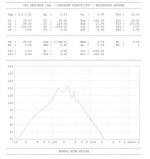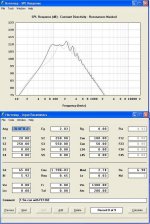I've bought the materials and plan to start building this weekend. Before I do, I'm hoping I can get a comment from planet10 or some of the other experienced horn designers/builders. Is there anything wrong, in principle or execution, with what I've done;
a. Take the frugal CC volume and expansion and refold it to fit in a taller box.
b. Change the throat cross section to a square.
c. Extend and reshape the mouth to fit in the taller box.
I don't want to build something if there is an obvious fatal flaw.
Thanks in advance.
Denis
a. Take the frugal CC volume and expansion and refold it to fit in a taller box.
b. Change the throat cross section to a square.
c. Extend and reshape the mouth to fit in the taller box.
I don't want to build something if there is an obvious fatal flaw.
Thanks in advance.
Denis
The 1st 2 are straight-forward. The 3rd is a bit of a shot in the dark... the flare at the end of the FH was already exceedingly quick.
dave
dave
Thanks Dave. I've redrawn the speaker to extend the path length and reduce the flare at the mouth.
Before I build anything, I've decided to try to first simulate the Frugel horn in Hornresp. I'm having limited success and I'm hoping for some more help with Hornresp.
I've attached a simulation of something close to the Frugel horn with the FE126E. The mouth is about 2/3 the area of the actual Frugel because that's as close as I can come without getting an error complaining about the mouth segment cir > 1.
My questions;
a. Is there any way to simulate the bigger mouth area/ flare rate in hornresp?
b. The SPL response on the sim I do have looks bad. This isn't anywhere close to what the response should look like, is it? I'm sure I'm doing something wrong.
Thanks
Denis
Before I build anything, I've decided to try to first simulate the Frugel horn in Hornresp. I'm having limited success and I'm hoping for some more help with Hornresp.
I've attached a simulation of something close to the Frugel horn with the FE126E. The mouth is about 2/3 the area of the actual Frugel because that's as close as I can come without getting an error complaining about the mouth segment cir > 1.
My questions;
a. Is there any way to simulate the bigger mouth area/ flare rate in hornresp?
b. The SPL response on the sim I do have looks bad. This isn't anywhere close to what the response should look like, is it? I'm sure I'm doing something wrong.
Thanks
Denis
Attachments
dhenryp said:The mouth is about 2/3 the area of the actual Frugel because that's as close as I can come without getting an error complaining about the mouth segment cir > 1.
Hi Denis,
The message is a cautionary one only - you can safely specify a larger mouth size. The results will still be accurate enough for all practical purposes.
Incidentally, I assume that the Frugel is a back-loaded design, in which case the Combined Response tool should be used to calculate the overall horn plus direct radiator SPL response.
Kind regards,
David
Thanks again David! I've used the combined response tool but the Frugel/Bugel is a rear firing back loaded horn. It would seem that the actual combined response would depend on exact placement with respect to back and side walls so I've decided on concentrating on the horn response by itself.
I've attached a simulation with the full mouth frugel and the additional mouth area makes virtually no difference.
Could Planet10, or some of the other Frugelhorn designers, comment on the simulation? It's down 5db at ~ 120 and 300hz. This seems to be too narrow and too high to provide bass help. Does this match simulations of the Frugel you've done or seen? I'm just trying to get a baseline so I have some confidence I'm using the tool correctly before I try simulating changes.
Thanks
Denis
I've attached a simulation with the full mouth frugel and the additional mouth area makes virtually no difference.
Could Planet10, or some of the other Frugelhorn designers, comment on the simulation? It's down 5db at ~ 120 and 300hz. This seems to be too narrow and too high to provide bass help. Does this match simulations of the Frugel you've done or seen? I'm just trying to get a baseline so I have some confidence I'm using the tool correctly before I try simulating changes.
Thanks
Denis
Attachments
dhenryp said:Could Planet10, or some of the other Frugelhorn designers, comment on the simulation? It's down 5db at ~ 120 and 300hz. This seems to be too narrow and too high to provide bass help.
Without the corner in the sim, it is all just a guess.
dave
Planet10 - The "Ang = .5 X Pi" indicates corner loading, or are you talking about something else?
dhenryp said:Planet10 - The "Ang = .5 X Pi" indicates corner loading, or are you talking about something else?
That wasn't clear.
Ron did the final work on the rear of the FH. Response to 60-70 Hz but his sw is able to consider everything including mix of TL/Horn action.
dave
I've been playing around with hornresp and have come up with a horn that fits in about the same size box as my original bugelhorn but simulates much better. It consists of two conical sections that are completely different than the original bugelhorn (and the current frugelhorn).
I've attached a picture comparing the new bugelhorn to my simulation of the original bugelhorn (which is essentially the same as the frugelhorn in hornresp).
The new design is down about 5db at 70hz and ~250hz with the FE126E. The FE108EZ SPL response is very similar. I'll attach the speaker layout in my next post.
I've attached a picture comparing the new bugelhorn to my simulation of the original bugelhorn (which is essentially the same as the frugelhorn in hornresp).
The new design is down about 5db at 70hz and ~250hz with the FE126E. The FE108EZ SPL response is very similar. I'll attach the speaker layout in my next post.
Attachments
misc
Hi Denis
Been following with interest and had a thought--dimensions starting to approach Ron's A126 (~0.6" wider and maybe 3" taller if I have your plan straight)
-> maybe try those dims in hornresp? I haven't/no idea--just a thought.
Appreciate your sharing & applaud your sense of adventure--good luck and go go go!!!
Hi Denis
Been following with interest and had a thought--dimensions starting to approach Ron's A126 (~0.6" wider and maybe 3" taller if I have your plan straight)
-> maybe try those dims in hornresp? I haven't/no idea--just a thought.
Appreciate your sharing & applaud your sense of adventure--good luck and go go go!!!
Dave - I would have preferred to have the mouth at floor level but I couldn't make it work with the path length and relatively thick cross section. I'm thinking that maybe the 14" height won't matter given the wavelengths involved (e.g. 100hz = 10 feet).
grindstone - thanks. Simulating the A126 in hornresp would be an interesting exercise. I may try it, but at this point, I'm pretty much committed to a new design.
Denis
Denis
I'm updating the drawings to make the horn easier to build. While I'm doing this I'm considering adding a curved mouth ala ronc's horns and the Frugelhorn with wings. It makes intuitive sense that a curved mouth would better produce a spherical wavefront. What's not clear is how to determine the diameter of the curve.
Should the diameter be a function of the low end cutoff frequency or is it more directly related to the mouth size or maybe something else entirely? The Frugel has a very large diameter curve while ronc's horns seem to have a smaller diameter.
Would Ronc, or one of the other horn gurus, care to shed some light on the topic?
Thanks!
Denis
Should the diameter be a function of the low end cutoff frequency or is it more directly related to the mouth size or maybe something else entirely? The Frugel has a very large diameter curve while ronc's horns seem to have a smaller diameter.
Would Ronc, or one of the other horn gurus, care to shed some light on the topic?
Thanks!
Denis
dhenryp said:Dave - I would have preferred to have the mouth at floor level but I couldn't make it work with the path length and relatively thick cross section. I'm thinking that maybe the 14" height won't matter given the wavelengths involved (e.g. 100hz = 10 feet).
I made an assumption a few posts back that having the mouth 14" above the floor wouldn't make a practical difference. Is my assumption correct or is there a significant benefit to be had by moving the mouth to the floor? I'll define "significant" as greater than one db and/or more than couple of hertz.
My logic is that hornresp must be assuming the mouth is literally at the corner of the room when you select corner loading and this is a good assumption because the wavelengths involved are on the order of ten feet and the actual distance from the corner is a fraction of that. Raising the mouth 14" only moves it a handful of inches further from the corner compared to a mouth exiting at the floor.
Thanks,
Denis
dhenryp said:I made an assumption a few posts back that having the mouth 14" above the floor wouldn't make a practical difference. Is my assumption correct or is there a significant benefit to be had by moving the mouth to the floor? I'll define "significant" as greater than one db and/or more than couple of hertz.
If it is as high as you show then it will be only loaded into quarter space instead of eigth space.
Since you can fit the horn into that volume, you should be able to refold it to work. I started but didn't have the payience/time/motivation to finish.
If i can find the drawing i'll post it... the 2 ends just need to be connected.
dave
Thanks Dave - after my original response I've gone back and refolded to exit at the floor. I'm asking the question to try to understand what's wrong with my reasoning.
- Status
- Not open for further replies.
- Home
- Loudspeakers
- Full Range
- Bigger Frugel horn (Bugelhorn?)



